
by PETER MILTON
The private world of stereo phones has attractions unmatched by the impersonal and "accurate" realm of loudspeakers, despite the fact that they have long been regarded as second-class substitutes for loudspeakers. This has tended to delay their recognition as genuine components instead of mere accessories to a hi-fi system. Tradition has forced us to expect that music should come from a single general direction and moreover, since music is an external happening, to be enjoyed properly, it should be shared. From this point of view, listening via headphones can be regarded as an antisocial activity.
However, there is a different way of looking at things. Loudspeakers, it is said, are becoming increasingly accurate, yet they only approximate the presence of the musicians, themselves only the means of communication between the composer and the listener.
Headphones produce sound which is often perceived as being inside the head. This is not a fault-music started out that way. Beethoven did not need his external physical ears to hear his last symphony.
Loudspeakers are part of the external world and aim to preserve the illusion of the source of music. Headphones are intensely personal and internal. Some can have appalling quality, but with the best, there can be an almost ecstatic and mystical joining with the spirit of the music. The very young have discovered this and, with fingers snapping and heads bobbing, strut their rhythmic way downtown, wearing their glittering mini-phones as symbols of their rejection of the real world of the '80s.
Many welcome the spread of the new style of headphones, for with each set sold there is one less transistorized radio to blare its tinny message across the quiet countryside. Wearing headphones can be seen as a sign of consideration rather than as unsociability.
Often, being compelled to share a symphony second-hand is disliked as much as being surrounded by second-hand cigarette smoke.
The current trend in headphone styling is towards the ultra-lightweight portable type, popularized by Sony with the Walkman series, although lightweights, such as those made by Sennheiser, have been available for several years.
There is a very wide range of styles and prices and, although you could pick up a pair of surprisingly good lightweight headphones for $25 or so, a set of top-quality electrostatics can easily cost more than a good pair of loudspeakers. The trick in choosing something as personal as a pair of stereophones, as in most other audio components, is to know what to expect from each type. Audio quality is an obvious criterion, but this is not always the deciding factor. Comfort, portability, and repeatability must also be considered. And there is the small matter of the budget, of course.
The operating principle of headphones is similar to that for loudspeakers. The signal from the amplifier drives a light diaphragm which, in turn, vibrates the air in the ear canal. The way the diaphragm is driven and the method of coupling the air to the ear determines the type of the headphone.
The first stereophones produced by John Koss were, in fact, small loudspeakers sealed at the rear by cardboard covers and mounted on a military headband. The modern stereo headphone is far more sophisticated, but there are still inexpensive "offshore" models to be found which simply use small loudspeaker drivers as the sound-producing elements.
It is easiest to understand how the various classes of headphones came into being by thinking in terms of a complete system, consisting of the combination of headphone driver and the human ear.

AKG uses electrostatic and dynamic transducers, together with
passive diaphragms, in their headphones.

Cutaway view of the Audio-Technica Planar Coil dynamic element.
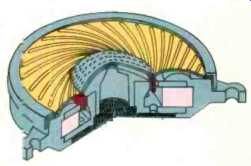
Cutaway
view of a typical Audio-Technica dynamic element.Note how the coil extends
downward into the gap.
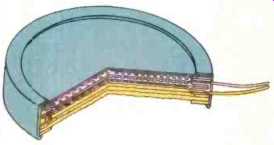
Cutaway view of a typical Audio-Technica electret condenser element.
In a normal hi-fi situation, the loudspeakers simulate the presence of the musicians and recreate the original pattern of soundwaves which existed in the studio. The sound travels to the listener, where it is modified by the complex folds of the external ear, or pinna, before it reaches the ear canal.
The resonances and acoustic shadows produced by the pinna determine, to a large extent, our perception of distance and direction. Headphones "short circuit" the pinna, and the output from the diaphragm is coupled directly to the eardrum so that many subtle aural clues are missing. Many of the early designers missed the point (and some still do) that the frequency response of the driver unit must make up for the effect of the pinna.
The shape of the external ear varies considerably, but it is possible to define, within broad limits, the sort of frequency response a driver should have in order to produce natural sound. Figure 1 shows a response envelope based on work done by Dr. A. G. Shaw of Ottawa, Canada, and Contributing Editor Jon Sank. An accurate frequency response in itself is not enough.
Work is still going on to reproduce the phase changes at the pinna which bring the headphone sound out of the head.
The direct coupling between the diaphragm and the eardrum removes the effects of the room but introduces problems of its own. As long as there is a complete seal, the total pressure change produced by the diaphragm is used to move the eardrum, and the response can extend down to d.c. This is a very useful way to extend the bass response and is the basis of the circumaural type of headphones, which use a large soft pad surrounding the complete external ear and act as a seal. There are several disadvantages to circumaural headphones in practice. From the wearer's point of view, the completely sealed ear cups and large pads are fairly heavy, and the lack of ventilation makes them hot and uncomfortable after a very short time. A more serious acoustical objection is that slight leaks caused by spectacle frames and the user's hairstyle reduce the bass response severely, and these leaks are quite unpredictable.
The situation is avoided by the use of supra-aural headphones, i.e., ones which rest on the outer ear. The cushions are often soft liquid- or foam-filled plastic rings, or they can simply be plain foam discs, as in the new lightweight types. The back of the diaphragm is open so that there is a controlled cancellation between the front and rear surfaces. In this type of driver, the response is arranged so that the movement of the diaphragm increases as the frequency is reduced, making up for the cancellation due to the huge leakage. The velocity of the diaphragm in this case is proportional to the amplitude of the electrical signal, hence the term velocity headphones for this class.
Naturally, the bass response cannot be extended indefinitely; the physical limits of the suspension determine the particular combination of sound output and bass extension which is practical.
A roll-off starting between 200 and 300 Hz is normal for the new style of headphones. Fortunately, loudspeakers having a well-damped and not overpowering bass are becoming more acceptable to the general listener so the open headphones do not lose too much by comparison.
The completely sealed headphones isolate the listener completely from the external world, and all the sounds produced in the studio, except those which are felt directly, can be reproduced. The 30 to 40 dB of isolation which can be achieved gives privacy-in both directions-but many listeners prefer to keep in touch with their surroundings and prefer the negligible isolation provided by the open types.
For them, the music provides sufficient masking and the ability to monitor conversation and background household noises.
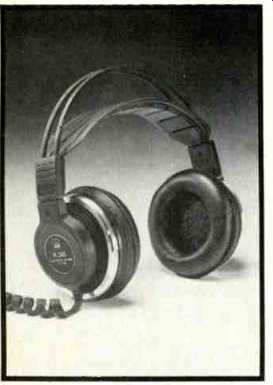
AKG K 340

The two basic methods of fitting the headphone to the ear.
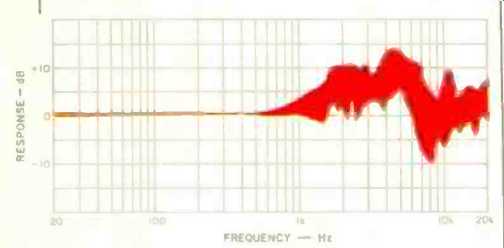
Fig. 1--The envelope into which headphone response must fall so that it
will sound natural.

Fig. 2--The basic parts of a moving oil speaker used in dynamic earphones,
as well as loudspeakers. (After G. J. King's The Audio Handbook.)
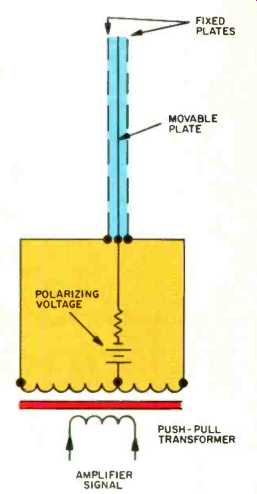
Fig. 3--The basic parts of an electrostatic speaker system. (After King.)
Headphones can also be classified according to the principle used to drive the diaphragm. The most common type is the electrodynamic, or more simply, the dynamic driver, which resembles a small speaker. The Koss dynamic stereophones, for instance, use a molded dome, similar to a tweeter in shape, which is driven at the edge by a relatively large diameter voice-coil moving in a circular magnetic gap. The outer suspension is molded with the diaphragm and contributes to some of the sound output.
Electrostatic headphones have the attractive feature of a very low-mass diaphragm which provides an excellent acoustic match to the surrounding air. An electrostatic charge is applied to the diaphragm, and the signal is fed to perforated plates on either side. The advantage is that the drive to the diaphragm is distributed evenly over the surface, and distortion due to breakup is eliminated. The clean drive and superb transient response make electrostatic headphones a natural choice for those who wish to have the very best, but the need for an outboard power unit makes them more expensive and not as simple to use as other types.
Electret headphones combine the advantages of electrostatics with the convenience of dynamic types. An electret is a permanently polarized material, currently one of the fluorocarbons, carrying a permanent electrostatic charge-the electrostatic equivalent of a permanent magnet. The Yamaha electret headphones use a thin metallized polyester diaphragm stretched between two perforated electret plates. The system operates in the push-pull mode, and by separating the function of the electret from the diaphragm, it has been possible to reduce the matching requirements to the use of a simple matching transformer.
The search for a uniform drive is not limited to electrostatic drivers. Toshiba uses an extremely thin polyester diaphragm which carries an integral spirally wound coil. The coil is divided into sections wound in opposite directions and is stretched between two waffle-shaped magnets. The poles are arranged so that the lines of magnetic flux pass radially across the surface of the coil, which ensures an even drive.
There are many ways to make a good set of stereophones--magnetic, electrostatic, even piezo-electric. At the moment, there is no internationally accepted way of defining the perfect response curve, although envelope response curves seem to be gaining acceptance. These curves are usually made with the driver resting on a rubber replica of a standardized human ear, with a probe microphone placed at the entrance to the ear canal. The mechanical model is not perfect, and considerable work is being done to bring the tests in line with actual perception.
Even if it were possible to reproduce an actual ear for the purposes of the tests, the choice of a set of stereo phones would still be an intensely personal matter since ears vary widely in shape and size. No one design can compensate for the elimination of the effect of the pinna completely. Consequently, no one listener can say definitively what is right for another. In this, the loudspeaker designer has the advantage since it is only necessary to provide a flat response in a given room; any acoustical compensation required is identical for all listeners.
The choice of a set of stereophones should be as thorough as looking for a suitable pair of loudspeakers. It could even be more time-consuming since quick A-B comparisons are not possible. Decide on the purpose of the headphones first. Are they to be used at home or are they for a portable personal system? Lightweight units are best for outdoor use. If the headphones are to be used with your hi-fi system, consider comfort and lightness versus deep, deep bass and complete privacy. You might want to try one of each type for a short while to see which is most comfortable for extended listening.
Once the style and price bracket have been decided, the choice will narrow down considerably. At this point you could examine the fit of the headband and the ease of adjustment.
Some ear pieces are difficult to adjust and will slip during use. Comfort is essential, and a clear favorite style will soon emerge. Once all but a handful of possible choices have been eliminated, the listening tests can begin.
These should not be conducted hastily. The acoustic perspective is usually completely different from listening with normal speakers, and an initial impression can be deceiving. Listen for a satisfactory balance between highs and lows. The open types sometimes have a slight peak in the upper bass to compensate for the lack of true depth.
As in speakers, a distant sound indicates a lack of middle frequencies.
Many drivers have resonant peaks which could compensate for the effect of the pinna except that they are displaced in frequency and so sound unnatural. The normal rules of listening still apply, so look for smoothness and a good overall balance. As a rough guide, cross-check in A-B fashion between the speakers and the phones while in your favorite chair.
The choice is wide and intensely personal; there are no absolutes. You may opt for perfect, although cumbersome, sound or casual comfort. Headphones are getting better all the time.
How will you know your choice is right? You will not know immediately, but I have always found, whether the item be a phono cartridge, speaker, a recording of a particular symphony or a pair of headphones, the best one for me is always the one which remains at hand. The rest have usually been given or put away.
(Source: Audio magazine, May 1982)
Also see:
Headphones around the house (May 1974)
Headphones: History and Measurement (May 1978)
Illusions for Stereo Headphones (Mar. 1987)
A History of Binaural Sound (Mar. 1986)
Build a Stereo Headphone Amp (May 1983)
= = = =